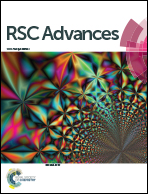In situ green oxidation synthesis of Ti3+ and N self-doped SrTiOxNy nanoparticles with enhanced photocatalytic activity under visible light
Abstract
A simple in situ green oxidation synthesis route was developed to prepare Ti3+ and N self-doped SrTiOxNy nanoparticles using TiN and H2O2 as precursors. X-ray diffraction (XRD), scanning electron microscopy (SEM) and high-resolution transmission electron microscopy (HRTEM) were used to characterize the crystallinity, structure and morphology. X-ray photoelectron spectroscopy (XPS) tests confirmed the presence of Ti3+ and N in the prepared SrTiOxNy nanoparticles. The resultant nanoparticles were shown to have strong absorption from 400 to 800 nm using UV-vis diffuse reflectance spectroscopy (UV-vis DRS). The formation mechanism of the Ti3+ and N self-doped SrTiOxNy nanoparticles was also discussed. Under visible light irradiation, the obtained Ti3+ and N self-doped samples showed higher photocatalytic activity for the degradation of the model wastewater, methylene blue (MB) solution. The most active sample T-130-Vac, obtained at 130 °C under vacuum, showed a 9.5-fold enhancement in the visible light decomposition of MB in comparison to the commercial catalyst nano-SrTiO3. The sample also showed a relatively high cycling stability for photocatalytic activity.



 Please wait while we load your content...
Please wait while we load your content...